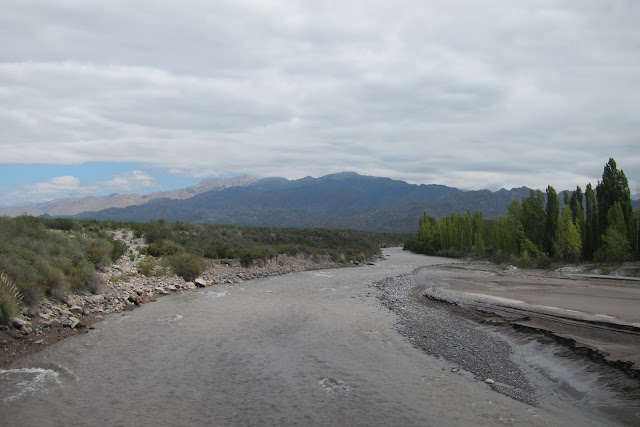Our final week of History and Culture with Marcelo Reynoso began with a conversation with Nahuel "Gatito" Jofre, a musician who specializes in Argentine folk music. We learned about the history and how folk music has evolved throughout South America. That afternoon we had an eye-opening conversation with a man named Nino, who is a representative from an organization that attempted to publicize the events of the "Dirty War", one of the darkest periods in modern Argentine history. The next day Marcelo discussed the topic of modern Argentinean politics and summarized the complete history from the Huarpes to the present day system. To complete the class we took a three-day trip to Valle de Uco to experience more Argentine culture.
 |
| Gatito explained Argentine folk music in words and music |
During the first day in Valle de Uco, our group attended a lecture from Jorge Difonso, the mayor of San Carlos, on the topic of mining and its effect on sustainability. Afterward we had the opportunity to speak with the mayor about these issues and gain further insight on the topic. To give us a different perspective on the mining issue, we listened to a women who belonged to the local anti-mining organization. She explained how the mine would affect the people in San Carlos on a personal level. To conclude the day, we shared mate and played games at Marcelo’s majestic casa.
 |
| Mayor Difonso explains sustainable development in San Carlos |
On our second day in San Carlos we had breakfast at Susana’s house. Susana shares one of eleven locations involved with the eco-tourism organization called Camino de Altamira. We learned how to make tostadas and had a delicious breakfast with her assortment of homemade jams. Then we walked to a nearby agricultural farm called El Melocoton, which is also part of the Camino de Altamira group. We learned about the honey making process and got to taste the sweet final product. Oscar, the farmer, showed us around the orchards and also displayed how he tills the fields with his tractor.
 |
| Susana and Marcelo explaining the concept of ecotourism embodied in Camino de Altamira |
In the afternoon, we went to an elementary school called Escuela de Viluco where we played with the children and learned about the modern Bolivian immigration to Argentina. It was really rewarding to spend time with the kids, even though they beat us in soccer, because of our mutual interests in each other’s lives.
 |
| Olivia making friends with a Bolivian boy |
 |
| Kris showing the boys how to take photographs |
 |
Kelsey playing El Lobo with the school children
The last day in San Carlos we were interviewed by two different local radio stations. We were asked questions regarding the TIES program and also questioned our views towards current issues in the Mendoza province. Courtney Allen became a local star with her on-air performance of Amazing Grace. |
 |
| Courtney making her radio debut. She signed autographs for the locals afterward |
Following our radio interviews, we visited INTA, which is a government organization that researches the improvement of agricultural goods. Following INTA, we went to two very different wineries to contrast between the styles of production. First we visited Bodega Appon, a very small operation, which is run by two brothers from San Carlos who have been in the industry for around fifty years. Afterwards we toured an enormous winery called Salentein. The Salentein vineyards cover over 700 hectares of prime real estate and they boast some of the most modern facilities in the region.
 |
| Late harvest vineyard in the foothills of the Front Cordillera |
We had an enjoyable trip to the beautiful city of San Carlos and we are all sad to see the program coming to a close. The TIES program has been very beneficial and educational for all students involved. Our experiences have been invaluable and have exposed us to new perspectives and ways of life.












































